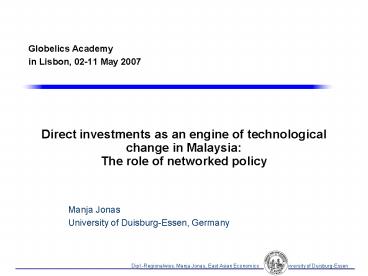Manja Jonas PowerPoint PPT Presentation
1 / 13
Title: Manja Jonas
1
Direct investments as an engine of technological
change in Malaysia The role of networked policy
- Globelics Academy
- in Lisbon, 02-11 May 2007
2
A. Motivation
- FDI-based development strategy Aim leveraging
foreign technology for local development - But Mixed results.
- Study question How can developing countries
facilitate effective technology diffusion from
FDI to local industry? - ? Innovation Systems (IS) as key facilitators of
technology diffusion (Freeman 1987 Freeman,
Nelson et al. 1988 Lundvall 1992 Nelson 1993) - ? Midwifery role of economic policy (Evans 1995)
- ? Greater social interaction leads to higher
levels of cooperation for the provision of local
public goods (White and Runge 1995 Molinas 1998)
3
B. Policy learning as network embedded
collective action
- - Policy learning as the process by which
consensual knowledge is used to specify causal
relationships in new ways so that the result
affects the content of public policy (Haas 1990
23) - - Respecification effort as a communicative
process of sense-making (Nedergaard 2006) - frequent communication leads to a certain
convergence of beliefs - Public good character of individual investments
in interaction and IS development (assuming a
certain commonality in the preferences and causal
relationship models of MNEs in the same industry) - ? collective action problems
- socially constructed trust and reputation may
facilitate collective action to build economic
institutions (Ostrom 2000, Tang 1994) - network management activities to facilitate
interaction activation, framing, mobilizing,
synthesizing (Carlsson 2000 Keast, Mandell et
al. 2005 Meier and O'Toole 2001 Klijn 1996
Klijn and Koppenjan 2000) - ? public network management may overcome
collective action problems
4
C. A unified framework of FDI embeddedness in
policy learning networks
5
D. Theoretical propositions
- Proposition 1 If collective action problems are
solved, MNEs integrate themselves into the local
policy network. - Proposition 2 If the state actively manages the
policy network, interactive policy learning is
facilitated. - Proposition 3 Technology policy is more
effective, if it builds on interactive policy
learning.
6
F. Data collection methodology
- Industry survey among 400 foreign-owned
enterprises from the US, Japan and Germany in the
electronic industry (response rate so far 10),
questionnaire administered over the phone or in
person by a professional survey company, whenever
possible use of tested survey instruments on
their technology-related networking - 22 personal semi-structured interviews with
representatives of Business associations,
training institutes in public-private
partnership, and public agencies on their
networking patterns with foreign-owned
enterprises in Malaysia
7
F. Innovation system issues
Business services Supplier base Infrastru
cture HR Regulation
Notes n27 values normalized from 5-point
Likert scale
8
G. Commitment and activism of FDI
Notes n28 A minimum value of zero denotes that
responses were on average not above the lowest
value, i.e. no special agreement on the matter.
The maximum is 4.0. Acquiescence bias was
eliminated by including two positively and two
negatively formulated items in each category, and
subsequently adjusting to the mean. Since the
items are heavily loaded with value judgements,
social desirability bias had to be controlled,
too. This was achieved by discounting the minimum
adjusted value for each respondent.
9
Proposition 1 If collective action problems are
being solved, MNEs integrate themselves into the
local policy network.
- Network Management by BAs
- Activation ?, private benefits
- Framing ?, unilateral or collectively
- Motivation ?, reputation mechanisms
- Synthesizing ?, interaction platforms,
equal contribution schemes - Examples of embeddedness council participation
ASIALICS PSDC
10
Proposition 2 If the state actively manages the
policy network, interactive policy learning is
facilitated. (the national level)
- Network management by national level public
agencies - Activation - ?, phone calls based on databases
- Framing -?, participatory (general
government- business meetings) or
top-down (dedicated councils) - Motivation ?, some use reputation
mechanisms, others remuneration - Synthesizing -?, equal contribution schemes
- Examples of interactive policy learning NPC
11
Proposition 2 If the state actively manages the
policy network, interactive policy learning is
facilitated. (the state level)
- Network management by (successful) local level
public agencies - Activation ?, private benefits
- Framing ?, participatory
- Motivation ?, reputation mechanisms, private
benefits - Synthesizing ?, equal contribution schemes,
networking platforms - Examples of interactive policy learning PSDC,
InvestPenang
12
Proposition 3 Technology policy is more
effective, if it builds on interactive policy
learning.
- Comparison between the evolution of industrial
training in PSDC (co-operative approach) and
SHRDC/KISMEC (top-down approach) - Comparison between supplier development
activities of InvestPenang (co-operative
approach) and SMIDEC (top-down approach initially
)
13
- Thank you very much!

